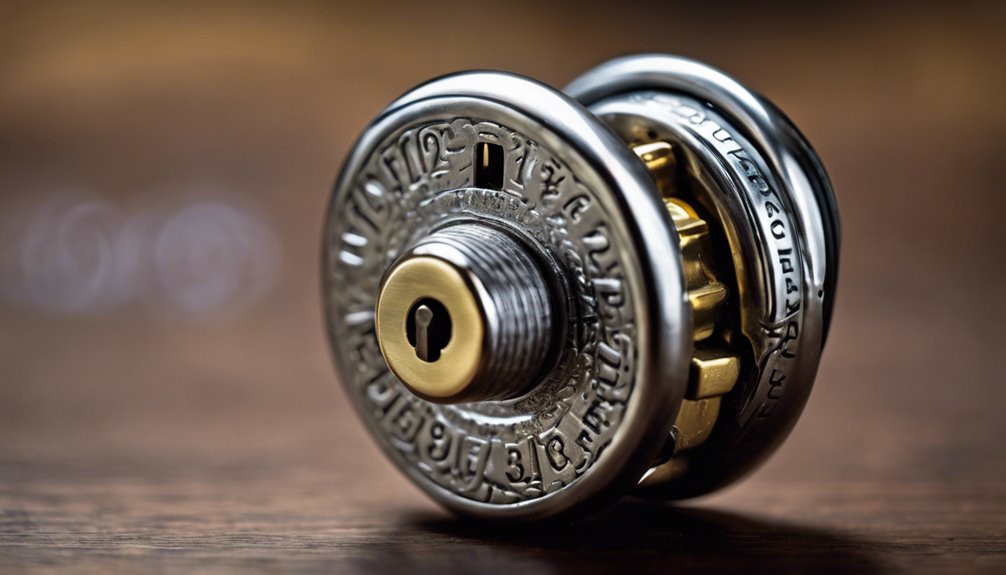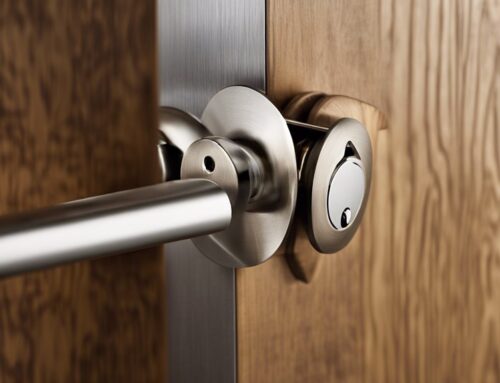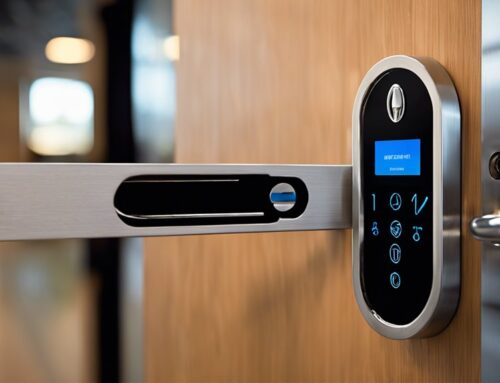A rotary combination lock is like a steadfast guardian standing watch over your valuables. You’ll find that these locks seamlessly blend classic design with modern safety features, offering intricate protection without the hassle of keys. Yet, while many appreciate their durability and reliability, it’s crucial to contemplate potential vulnerabilities in our tech-driven world. How can you guarantee your chosen lock remains a true sentinel amidst evolving security threats? The answers might surprise you, as there’s more than meets the eye when it comes to these time-tested solutions.
Key Takeaways
- Rotary combination locks provide enhanced security, making them a reliable option for safeguarding valuables compared to traditional key locks.
- These locks eliminate the risk of lost keys, simplifying access to secured spaces without the need for physical keys.
- Crafted from durable materials, rotary combination locks resist wear and tear, ensuring long-lasting performance in various applications.
- They are ideal for securing items in home safes, gym lockers, and storage units, adapting well to different security needs.
- Awareness of potential vulnerabilities and the importance of regular maintenance help in ensuring these locks remain effective and trustworthy.
Anatomy of Rotary Combination Locks

The intricate design of rotary combination locks combines functionality with clever mechanics.
You’ll find several key components in these locks: the dial, spindle, and gear assembly. The dial, marked with numbers, is where you input your combination. As you rotate the dial, it engages the spindle, which turns the internal gears.
These gears translate your dial movements into precise mechanical actions. This exceptional engineering guarantees that only the correct sequence of numbers can align the internal locking mechanism, granting access.
Familiarizing yourself with these parts not only boosts your understanding but empowers you to appreciate the sophistication behind every click. Mastering this knowledge is essential for anyone looking for security solutions that merge reliability with innovative design.
Operating Mechanism Explained

When you turn the dial of a rotary combination lock, you initiate a series of mechanical movements that work in harmony to secure or release the locking mechanism. Each notch turns a gear, aligning it with a specific combination of gears known as the locking bolt.
As you turn, you engage pins within the cylinder that either fall into place to secure the lock or align to allow the bolt to slide free. Your precise movements disengage the intricate dance between the components—each click indicating your progress.
Understanding this mechanism enhances your appreciation for craftsmanship and security. Mastering the dial’s manipulation empowers you, offering confidence in the lock’s reliability and efficacy for safeguarding valuables in an increasingly uncertain world.
Benefits and Drawbacks

Rotary combination locks offer a mix of advantages and drawbacks that are essential to contemplate before choosing them for security needs.
- Enhanced Security: These locks can provide superior safety compared to traditional key locks, reducing the risk of picking or unauthorized access. High-security options often include advanced features that further deter tampering.
- No Keys to Lose: With a combination to remember, you eliminate the concern of misplacing keys, making these locks user-friendly.
- Durability: Crafted from robust materials, they resist wear and tear more effectively than many alternatives.
However, the complexity of remembering the combination can be a drawback, and the potential for mechanical failure exists. Additionally, high-security locks can offer increased protection levels due to their advanced features designed to prevent tampering.
Weighing these pros and cons will help you make an informed decision that aligns with your security requirements.
Security Innovations and Weaknesses

In today’s rapidly evolving security landscape, innovations continually emerge to enhance the effectiveness of rotary combination locks while also exposing them to new vulnerabilities. Advanced materials, such as reinforced alloys and smart technology integrations, bolster physical security and user convenience.
However, these same advancements can introduce points of failure. For instance, smart locks may rely on digital interfaces that are susceptible to hacking or software glitches, compromising overall integrity. The use of AI-driven threat detection can enhance the monitoring of secure entry points, providing an additional layer of protection.
You must recognize the balance between innovation and security; every new feature can present an opportunity for unauthorized access. Mastering these locks requires not just understanding their mechanisms but also being aware of their limitations. Additionally, understanding the risks of smart lock vulnerabilities is crucial as you navigate your choices in security.
Being informed about potential weaknesses empowers you to make strategic choices for your security needs.
Practical Applications and Uses

While you might think of rotary combination locks primarily for securing doors, their practical applications extend far beyond that.
These locks provide versatile security solutions you can implement in various scenarios, ensuring your valuables remain protected.
Consider the following uses:
- Safes: Equip your home safe with a rotary combination lock to shield important documents and assets. These locks are often preferred for their reliable security features, which can deter unauthorized access.
- Gym Lockers: Use them in gym lockers for personal belongings, providing a reliable barrier against theft.
- Storage Units: Many storage facilities implement rotary combination locks, allowing you to access your items only when needed.
Additionally, it’s crucial to stay vigilant and recognize signs of lock deterioration to maintain the integrity of your security measures.
Frequently Asked Questions
Can I Reset My Combination Without a Change Key?
You can’t reset your combination lock without a change key.
The change key is essential for accessing the mechanism that alters the code. If you’ve lost it, your best bet is to consult the manufacturer’s instructions or customer service for assistance.
Often, they can guide you through the process, and in some cases, you might need to supply proof of ownership to reset the combination securely without the key.
How Do I Know My Lock Is Installed Correctly?
Imagine installing a lock but finding it jammed after a week. To guarantee your lock’s installed correctly, check its alignment; the shackle should fit snugly without resistance.
Make sure it’s flush with the door or surface, and listen for a definitive click when securing it. Inspect the mounting hardware for tightness and examine for unevenness.
Regularly test the combination to confirm the mechanism’s functionality, guaranteeing smooth operation for long-term security.
What Happens if I Forget My Combination?
If you forget your combination, don’t panic.
First, check if you’ve noted it somewhere secure. If not, some locks have a reset feature, requiring you to follow specific steps.
In some cases, you may need to contact the manufacturer for guidance or provide proof of ownership.
Mastering these steps not only guarantees access but strengthens your understanding of lock mechanisms, ultimately enhancing your overall security strategy.
Always prioritize keeping your combination safe!
Are There Specific Maintenance Tips for Rotary Locks?
Think of your rotary lock as a trusted guardian of your valuables.
To keep it in peak condition, you should regularly clean the mechanism with compressed air to remove dust and debris.
Lubricate it with a graphite powder, ensuring smooth operation.
Check for any signs of wear and adjust the settings if necessary.
How Long Do Rotary Combination Locks Last?
Rotary combination locks can last many years, often ranging from 10 to 20 years or more, depending on usage and maintenance.
You’ll want to regularly check for signs of wear and lubricate the mechanism to guarantee smooth operation.
Choosing high-quality locks also contributes greatly to longevity.
Conclusion
In a world where security is paramount, rotary combination locks stand as the stalwarts of protection. Think of them like a fortress gate: strong, reliable, but not invulnerable. Just as a castle might upgrade its defenses against new threats, you should remain vigilant and informed about potential vulnerabilities in your locking mechanisms. By understanding both the strengths and limitations of these locks, you empower yourself to make the best security choices for safeguarding your valuable possessions.







